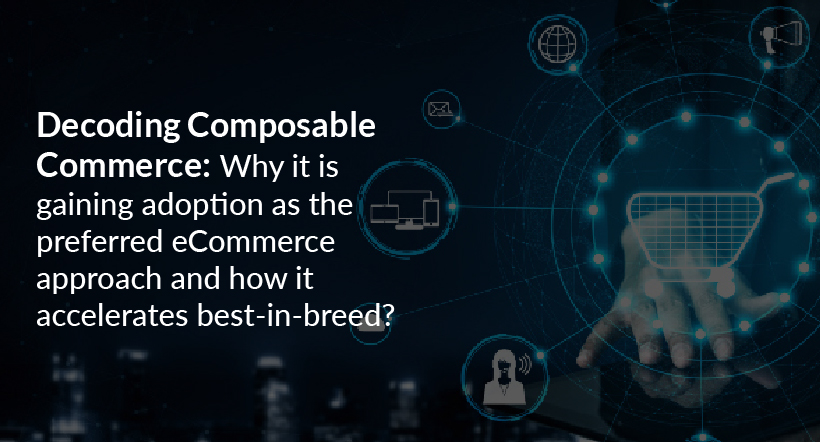At the start of online commerce last century, software vendors offered a traditional simplistic, one-size-fits-all monolithic solution that strived for a complete set of base commerce functionality in a single platform. In the early days of ATG and Blue Martini, eCommerce platforms provided the framework for eCommerce, with basic capabilities, the rest was customizable. As time progressed, eCommerce platforms with more robust capabilities were released as a Software as a Service, SaaS, architecture, which brought the cost down, but limited the ability to customize and add unique features. They were still monolithic, but provided easier adoption and use by more merchants. Merchants hoped that their SaaS provider would keep adding new capabilities as demand shifted; this did not always happen. If it did, it took some time. Ultimately, the cost of framework and limited SaaS customization abilities led to the rise of adding point solutions and the ‘best-in-breed’ approach.
The next trend, which all merchants should consider, is a headless or a composable approach. This approach combines the customization capabilities of an eCommerce framework and the SaaS or PaaS benefits like scalability, cost, security, etc. It brings these to all sized merchants, emboldening them to become customer experience revolutionaries to leapfrog their competition and gain share of their customer’s wallets. This whitepaper provides an overview of how composable commerce is reimagining the best-in-breed approach and why it is quickly becoming hyper-relevant in today’s business landscape.
Best-in-breed and how composable makes it easier.
Just like Google Search raised the bar for sites to up their game on their own site search, Amazon and other top sites used a hyper-focused customer experience and personalization driven approach to optimize their conversion rates and revenue. Traditional eCommerce platforms attempted to support a best-of-breed approach by building, or partnering with other companies to offer a range to their clients of optional add-ons or extensions like image zoom, payment processing, ratings & reviews, product recommendations, etc. Their platform clients could purchase and integrate these into their site as needed. Adding all these solutions and customizing other areas may not have been possible for smaller merchants who were less able to justify the cost. For larger merchants, small improvements in conversion equated to huge revenue increases and it was cost justifiable and relatively easy to use this approach to improve key capabilities outside their core eCommerce platform. However, there were some limitations to this approach, they could not decouple core eCommerce capabilities in their platform. Swapping out components like the cart, account, catalog, search, etc., was either not possible or very difficult and expensive (even for them) and would usually need a comprehensive data integration and front end customizations.
As these larger merchants pushed the customer experience to new levels, the demand kept increasing for all sites to deliver a similar and even more engaging and personalized customer experience. The end customers became accustomed to it, and expected this experience everywhere they shop, regardless of channel and size of the merchant. Since merchants with monolithic platforms are not able to evolve as fast as their customers desire, they are embracing and are undergoing a fundamental shift from their last generation monolithic eCommerce architectures toward a composable eCommerce architecture.
The composable approach allows companies to ‘compose’ their customers’ experience by swapping out even core functionalities to optimize the customer experience. Composable commerce empowers even smaller merchants to keep pace with rapidly evolving consumer behaviors and expectations and gives the flexibility of a best-in-breed approach.
So what really is composable commerce and what is its impact?
At its core, composable commerce refers to a modular architecture approach that uses back end APIs to deliver smaller, highly targeted eCommerce capabilities to the front end experience that are customizable, flexible, and scalable. The back end and the front end are kept separate to speed up development and testing. This is because these specialized, composable features can be built and tested separately on the back end and the front end, then put together when they are needed. With composable commerce, merchants can mix and match different services, called Packaged Business Capabilities, or PBCs, from multiple vendors. PBCs can be things like Cart & Checkout, Search, Promotions, Product Catalogs, Payment Gateways, etc. They can use these PBCs to create their own unique customer experience in order to quickly address and adapt to the ever-changing customer. Just by their nature, Composable Force companies are more agile and responsive to customer and business needs; they adapt much faster and stay ahead of their competition.
Why not just go with a headless approach?
Enterprises today use headless commerce and composable commerce interchangeably. But they are fundamentally different concepts. Both let merchants choose and customize the frontend experience separately from the backend functionality, enabling greater flexibility and customization for businesses to create unique and differentiated eCommerce experiences. However, while headless commerce separates the frontend from the backend, composable commerce takes this a step further by breaking down the entire eCommerce stack into smaller, independent services, PBCs, that can be combined and orchestrated to deliver specific functionality. This modular architecture provides greater granularity, flexibility, scalability, and agility for businesses to integrate specific services, modules, and third-party solutions as needed to create a tailored eCommerce solution and to adapt to changing market conditions and customer needs.
Nearly every composable eCommerce solution is headless, but not all headless eCommerce solutions are composable. When evolving to the next generation of eCommerce architecture, it is recommended to skip a strictly headless solution and go with a composable solution where your technology ecosystem will not be limited in the future as it may be now with a monolithic platform. The good news is that most headless eCommerce tools have been evolving towards a composable approach, so this may not be an issue for much longer.
How does Composable accelerate the best-in-breed approach?
When I was a teenager, I was always working on my car, making it better by adding a performance camshaft or new carburetor to give it more horsepower and speed. I composed my car by adding engine improvements and a new stereo so that it was unique and tailored to my specific needs. It is the same thing with Composable.
Composable commerce, just like traditional monolithic ecommerce platforms, allows the addition of best-in-breed third-party solutions, but it also allows for the consumption of smaller eCommerce bits that a monolithic platform cannot decouple. By its definition, Composable allows merchants to ‘compose’ their site with many solutions. This architecture drives a more modular and flexible approach to eCommerce, enabling merchants to rip out pieces of their eCommerce engine, even core capabilities, and replace them with higher performing parts. They quickly swap out and change any capability to stay ahead of their customers’ needs, the competition, and ultimately to drive better conversion and revenue. If one component needs improvement, another vendor’s PBC can be added to replace it. Having many composable PBCs from different vendors will have its own challenges, like multi-vendor management and integration, but this was always the case in the past with the best-in-breed approach. Composable commerce strives to lessen the impact of this through its flexibility and its decoupling of the front and back end architectures; swapping out code is much easier. If a new back end PBC is added, it can be built and tested separately before being added to the front end and A/B tested with end customers to validate the impact on the business. If it does not pass, simply remove it, and only use the original PBC.
How Composable drives flexibility and speed while reducing dependence on a single vendor
In the past, I’ve heard clients say that they decided to jump on the Netsuite, Oracle, or Microsoft bandwagons and base their entire business on those vendors’ products. They did this to simplify integrations between systems so they could focus on running their business. In this world, separating eCommerce from the ERP needed a lot of complex integrations. These clients would come to me for help with separating eCommerce and building a new site on a more advanced monolithic platform. We used a lot of cron jobs and flat file integrations. However, with the rise of middleware ETLs like Mulesoft, it became much easier to integrate a new eCommerce platform into their ERP so they could run their online store independently. Composable does something similar, but within the eCommerce system. However, it does not require complex integrations to do it, all data is passed via smaller APIs that are interwoven into the customer front-end experience. The composable architecture drives innovation and offers many benefits over the traditional best-of-breed approach, including:

Flexibility
Composable eCommerce platforms provide greater flexibility than monolithic platforms by allowing businesses to select and integrate best-of-breed PBCs or components, from multiple vendors to improve both core and non-core functions. Merchants can easily swap out modules as needed without affecting the rest of the system, allowing for greater experimentation and customization to quickly create a tailored eCommerce solution that can adapt quickly to changing market and customer needs while avoiding the need for a complete platform overhaul as they grow.

Scalability
Due to the nature of decoupling the front end and back ends, composable solutions are highly scalable. Businesses can scale each component independently, or change an individual component that isn’t performing or meeting their customer expectations. For example, during high traffic periods, businesses can scale up modules that handle user authentication or payment processing, while leaving others unaffected.

Better customer experience
Composable eCommerce platforms enable businesses to create a personalized, seamless customer experience by integrating more granular capabilities from best-of-breed component vendors that meet specific customer needs. This integration can improve customer satisfaction, increase repeat business, and lead to higher sales.

Cost efficiency
Composable eCommerce platforms can reduce costs several ways. First, by allowing merchants to purchase only the components they need, avoiding the cost of a complete platform that includes unnecessary features. Second, by using a modular development approach where each PBC is smaller than a full eCommerce platform, merchants can swap out these smaller components quickly AND develop / test their front and back end code separately; building both ‘ends’ is easier and less complex. And third, merchants can price shop between vendors and avoid vendor lock-in by switching out components as needed to find the most cost-effective solution.

Speed of Innovation
Composable eCommerce platforms enable merchants to innovate and stay ahead of the competition by quickly and easily integrating new components or technologies into their eCommerce solution. Merchants can develop each component, front, and back end, independently and then assemble them into a cohesive whole. This allows for more efficient development processes, since changes and improvements to one area don’t affect others. The speed of innovation empowers the creation of a better customer experience, increase sales, and improve operational efficiency.

Experience Optimization
Merchants can try several different components from different vendors, run them in the back end at the same time, and A/B/C/D test them on the front end to best identify which one drives the most improvement in their KPIs and customer experience.
Conclusion
Composable commerce is becoming hyper-relevant in today’s business landscape as businesses strive to keep pace with rapidly evolving consumer behaviors and expectations.
Although both headless and composable provide businesses with greater flexibility, specialization, and scalability, which can lead to faster and more efficient development processes and improved customer experiences, composable ecommerce solutions have better flexibility from their more independent and modular nature.
As an approach that allows enterprises to assemble their eCommerce systems from various best-of-breed solutions, a composable approach offers the best flexibility to select and integrate the most suited solutions for each component of their eCommerce stack.





